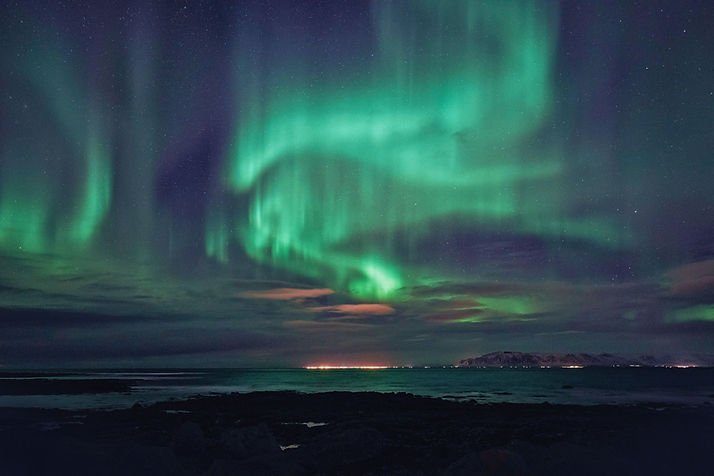
Reykjavik, the capital city of Iceland, is a vibrant and charming destination that offers a unique blend of natural beauty and urban sophistication. Known for its stunning landscapes, geothermal wonders, and rich cultural heritage, Reykjavik is a city that captivates and inspires travellers from around the world. As the northernmost capital of a sovereign state, Reykjavik is a place where the magic of the natural world meets the creativity and warmth of its people.
A Brief History
Reykjavik's history dates back to the 9th century when it was settled by Norsemen, led by Ingolfur Arnarson, who is considered the city's founder. The name "Reykjavik" translates to "Smoky Bay," referring to the steam rising from the area's hot springs. Over the centuries, Reykjavik grew from a small farming settlement to a bustling trading town. In the 18th century, it became the political and administrative centre of Iceland, and in 1786, it was granted official town status. Today, Reykjavik is a modern and thriving city that celebrates its Viking heritage while embracing contemporary innovation and sustainability.
Reykjavik, Iceland
Attractions and Activities
Reykjavik offers a wealth of attractions and activities that cater to all interests. Here are some must-see sights:
Hallgrímskirkja: This iconic church is one of Reykjavik's most famous landmarks. Its unique design, inspired by Iceland's basalt columns, makes it a striking sight. Visitors can take the lift to the top for panoramic views of the city and surrounding landscapes.
Harpa Concert Hall and Conference Centre: A stunning example of modern architecture, Harpa is home to the Iceland Symphony Orchestra and hosts a variety of concerts, events, and exhibitions. The building's glass façade reflects the changing light of the harbour, creating a mesmerising display.
Sun Voyager (Sólfar): This steel sculpture by Jón Gunnar Árnason is a symbol of exploration and discovery. Located along the waterfront, it offers a beautiful spot to watch the sunset and take in the views of the mountains and sea.
Perlan: Perlan, or "The Pearl," is a unique building that houses a museum, a planetarium, and a rotating glass dome with a panoramic viewing deck. Visitors can learn about Iceland's natural wonders and enjoy breathtaking views of Reykjavik.
Reykjavik Art Museum: Comprising three different venues, the Reykjavik Art Museum showcases contemporary Icelandic and international art. Highlights include the Hafnarhús, Kjarvalsstaðir, and Ásmundarsafn locations, each offering a distinct artistic experience.
Culture
Reykjavik's cultural scene is as diverse as its history. The city is a hub of creativity, with a thriving arts and music community. Visit the National Museum of Iceland to explore the country's rich history and heritage, or enjoy a performance at the National Theatre of Iceland. Reykjavik is also home to numerous music festivals, including the Iceland Airwaves and the Reykjavik Arts Festival, ensuring there's always something happening.
Icelandic cuisine is a delightful blend of tradition and innovation. Don't miss the chance to savour local dishes such as hákarl (fermented shark), plokkfiskur (fish stew), and skyr (Icelandic yogurt). Reykjavik's culinary scene also includes a wide variety of international cuisines and trendy food markets like Hlemmur Mathöll and Grandi Mathöll.
Best Time to Visit
Reykjavik is a year-round destination, each season offering its own unique charm:
Spring (March to May): Mild temperatures and blooming flowers make spring an ideal time to explore the city's parks and gardens. The city's outdoor cafes and terraces come to life as the weather warms up.
Summer (June to August): Enjoy long days, the midnight sun, and numerous outdoor festivals and events. Reykjavik's coastal areas and nearby natural attractions provide a refreshing escape during the summer months.
Autumn (September to November): Experience the beauty of autumn foliage and fewer crowds. Autumn is a great time to explore Reykjavik's cultural attractions and enjoy the city's cosy cafes.
Winter (December to February): Reykjavik transforms into a winter wonderland with festive Christmas markets, ice skating, and cosy cafes. Don't miss the chance to experience the northern lights, a magical natural phenomenon visible during the winter months.
Suggested Itinerary
Day 1: Start your journey with a visit to Hallgrímskirkja, exploring its unique architecture and panoramic views. In the afternoon, head to the Reykjavik Art Museum to admire contemporary Icelandic and international art. End your day with dinner at a traditional Icelandic restaurant in the city centre.
Day 2: Spend your morning at the National Museum of Iceland, learning about the country's rich history and heritage. In the afternoon, visit Harpa Concert Hall and Conference Centre for a guided tour and enjoy a performance or exhibition. Enjoy an evening in the vibrant district of Laugavegur, known for its trendy bars and restaurants.
Day 3: Take a leisurely stroll to the Sun Voyager sculpture and enjoy the views along the waterfront. In the afternoon, visit Perlan to explore its museum and planetarium, and take in the panoramic views from the glass dome. End your day with a dinner cruise on Faxaflói Bay, enjoying the city's illuminated skyline.

Local Tips
Public Transport: Reykjavik's public transport system is efficient and reliable. Purchase a Reykjavik City Card for unlimited travel on buses and free or discounted entry to many attractions.
Walking: Reykjavik is best explored on foot, so wear comfortable shoes and be prepared for a lot of walking, especially in the city centre.
Language: Icelandic is the official language, but most locals speak English, especially in tourist areas.
Tipping: Service charges are usually included in bills, but rounding up or adding a small tip for excellent service is appreciated.
Travel Tips
Emergency Numbers:
Police, Fire, Ambulance: Dial 112.
Medical Emergencies: Dial 112.
Nearest Airports:
Keflavik International Airport (KEF): Located about 50 km (31 miles) southwest of Reykjavik, it's easily accessible by bus, taxi, and shuttle services.
Nearest Train Stations:
Reykjavik does not have a train station as there are no railway services in Iceland. Instead, the city relies on buses and other forms of public transport.
Commonly Asked Questions
Q: What is the best way to get around Reykjavik? A: The best way to get around Reykjavik is by using the efficient public transport system, which includes buses. Walking is also a great way to explore the city's historic centre.
Q: Are there any free attractions in Reykjavik? A: Yes, many of Reykjavik's parks and public spaces are free to explore. Additionally, some museums offer free entry on specific days or times.
Q: What should I pack for a trip to Reykjavik? A: Pack layers, as the weather can be unpredictable. Comfortable walking shoes are essential, and in winter, warm clothing and a good coat are a must.
Reykjavik is a city that captivates visitors with its rich history, stunning architecture, vibrant cultural scene, and warm hospitality. Whether you're exploring its iconic landmarks, savouring the flavours of Icelandic cuisine, or simply soaking in the ambiance of its historic streets, Reykjavik promises an unforgettable experience. With this comprehensive guide, you are well-equipped to discover the best that Reykjavik has to offer, ensuring a memorable and enriching journey to this Icelandic gem.
Happy travels and enjoy your time in Reykjavik! 🌍✈️












